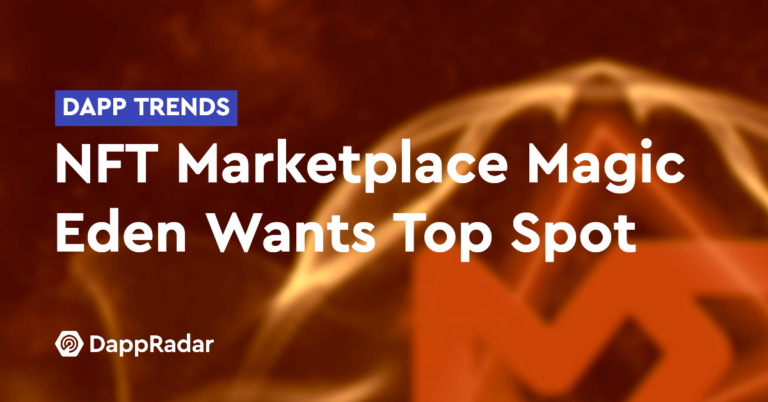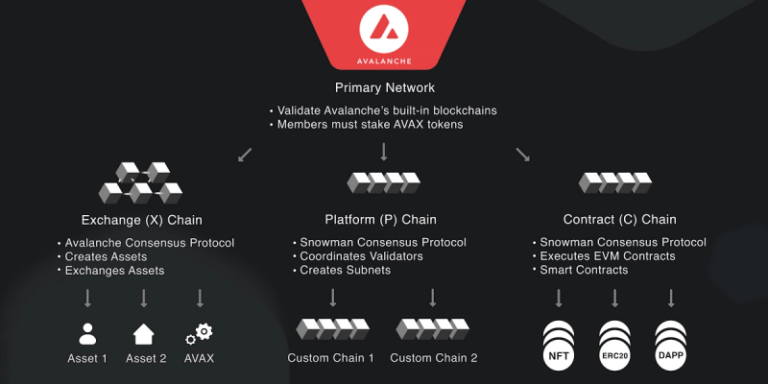Key Insights
- IoTeX is a decentralized smart contract platform that enables secure communication between IoT-powered devices in the real-world.
- It rewards device owners for sharing verifiable data from real-world activity with Web3 decentralized apps, while retaining full control over data.
- Active IoTeX hardware devices – Ucam and Pebble – nearly reached 17,000 in August 2022, up 140% YoY; IoTeX plans to also onboard legacy IoT devices.
- IoTeX transactions and active wallets grew 115% and 114% YoY, respectively.
- With MachineFi, IoTeX has the unique opportunity to lead the charge in enabling a new generation of decentralized apps powered by real-world IoT data.
How IoTeX Works
Thanks to the Internet of Things (IoT), devices in the real-world are getting smarter — be it wearables, home appliances, or connected cars. The number of IoT devices connected to the Internet could reach 29 billion worldwide in 2030. The economic value created by these devices may reach $13 trillion by 2030 — that’s more than half of the U.S. GDP in 2021 ($23 trillion).
What currently hinders this potential from realization is that IoT devices are somewhat siloed. Think of an Alexa not speaking with an Apple Watch. Or a Tesla not communicating with local Arduino weather stations. There’s an inherent design limitation preventing IoT devices from communicating with each other. IoTeX aims to bridge this gap by enabling secure communication between various IoT devices.
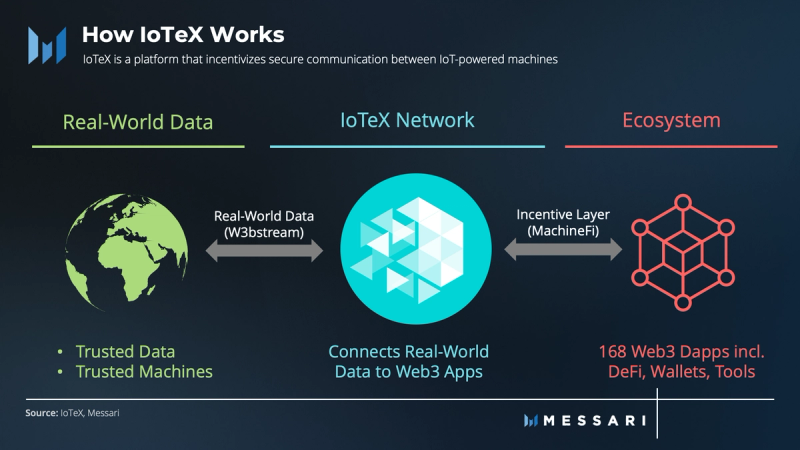
To prove activity in the real-world, IoTeX collects raw data from tamper-proof, IoT devices via a network of decentralized nodes (W3bstream). W3bStream enables two-way communications between IoT devices in the real-world and Web3 decentralized applications (dapps). In this sense, IoTeX technology serves as a platform for developers to build dapps. At the same time, with MachineFi, IoTeX provides an incentive layer for IoT device owners. That is, device owners are rewarded for sharing real-world activity with dapps. This enables a new generation of dapps powered by real-world data.
Technology in a Nutshell
At its core, IoTeX is a smart contract platform for bootstrapping large-scale machine networks in the real-world. IoTeX enables dapps that leverage these machine networks for everyday usage. The IoTeX tech stack consists of the IoTeX blockchain, a middle layer, and a suite of tools.
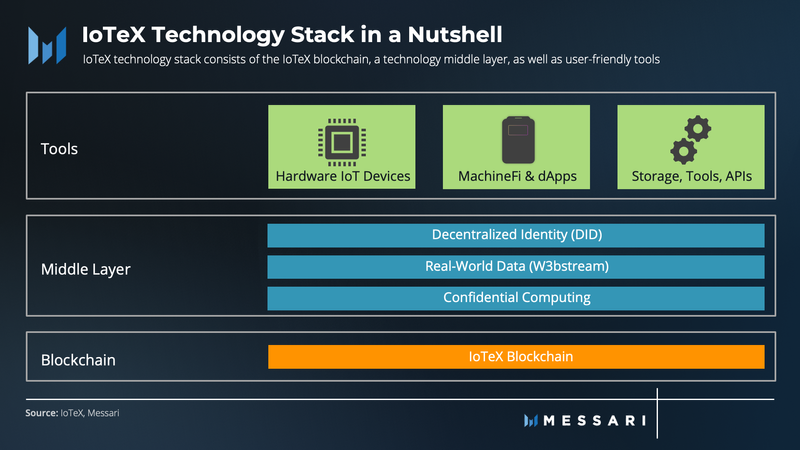
IoTeX Blockchain
To establish consensus efficiently and achieve instant finality, IoTeX employs a randomized Delegated Proof-of-Stake variant called Roll-DPoS. Roll-DPoS generates a pool of validator nodes – consensus delegates – via a community voting process. These consensus delegates produce blocks and validate transactions.
Middle Layer
Atop the IoTeX blockchain is an EVM-compatible middle layer of protocols facilitating smart contract capabilities. This middle layer includes a Decentralized Identity (DID) framework and a real-world data framework (W3bstream) optimized for confidential computing.
The DID is a globally unique, persistent identifier that doesn’t require a centralized registration. It verifies and identifies devices registered on the network. With an IoTeX DID, device owners can control their identity across the IoTeX network using a private key.
To process large-scale real-time data and mitigate the risk of sharing corrupted IoT device data to dapps, IoTeX developed the W3bstream protocol (formerly Truststream). W3bstream collects verifiable data from trusted devices with specific tamper-proof hardware requirements, i.e., secure chips. It then employs WASM virtual machines to enable computation on top of that data. Subsequently, it emits privacy-preserving proofs such as zero-knowledge proofs to attest certain behaviors of users or certain events happened in the physical world.
With Confidential Computing, IoTeX ensures that secure computing happens on-device, i.e., within the trusted execution environment (TEE) of users’ hardware. This removes the need to decrypt user data and preserves user privacy.
Tools
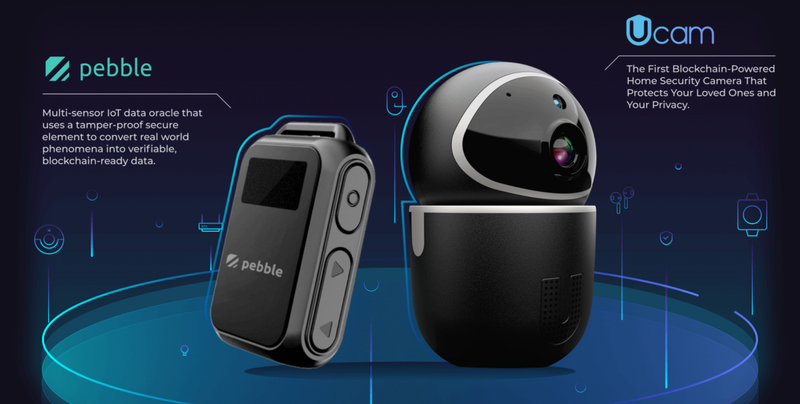
The middle layer supports a new generation of IoTeX-enabled hardware devices that are manufactured on-demand and shipped to users. As of August 2022, the two such hardware devices released by IoTeX are Pebble and Ucam:
- Pebble is a real-world GPS data tracker with trusted execution environments (TEE). Its sensors detect signals, e.g., user location, motion, humidity, and light.
- Ucam is an IoTeX-pioneered home security camera. It leverages DID — only the camera owner can access the private key. This private key is used to end-to-end encrypt all recorded video data via on-device edge computing. This ensures Ucam owners have complete control over their privacy.
Legacy IoT devices without blockchain capabilities are supported by IoTeX through additional hardware and software upgrades.
Launched in November 2021, MachineFi enables device owners to connect, share, and monetize IoT device data. With the beta release of the MachineFi Portal in January 2022, device owners are rewarded with IoTeX standard tokens (XRC-20) for connecting their devices and transmitting data from real-world activity. This data, in turn, unlocks new dapps with real-world use cases.
Additionally, the IoTeX tech stack supports IoT-based dapp development with customized tools, APIs, and decentralized storage.
Network Usage
IoTeX network usage can be assessed by the number of active IoTeX devices, the number of daily active wallets holding IOTX, the number of transactions, and the total value of locked IOTX.

Pebble and Ucam are the two IoTeX-pioneered hardware devices. These devices first need to be registered on the IoTeX network in order to be active. Ucam launched in Q4 2020 and has been ever since increasingly adopted; as of August 2022, there are over 14,500 active Ucams. Pebble launched in Q4 2021 and there are currently almost 2,300 active Pebble trackers. Its adoption is set to continue, as the IoTeX team is committed to forming partnerships (see the “Enterprise Efforts” section for details).
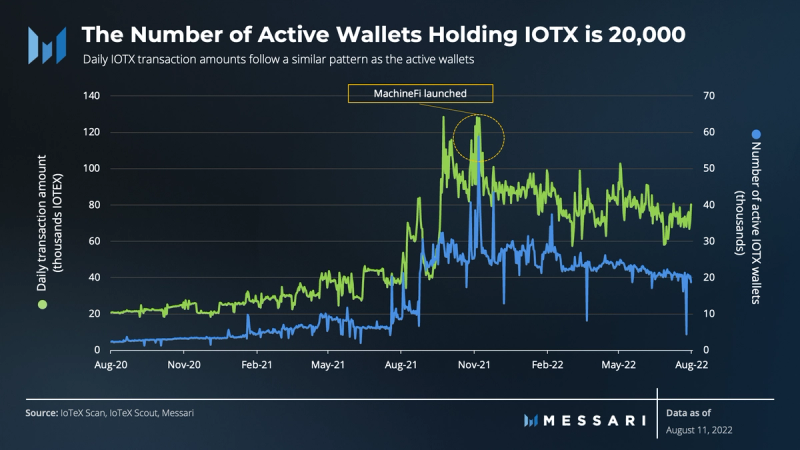
As of August 2022, the number of cumulative active wallets has exceeded 521,000; the number of daily active wallets holding IOTX is approximately 20,000, in line with the number of active IoTeX devices (17,000). As expected, daily transaction amounts follow a similar pattern as the active wallets. Notably, the rise in active IoTeX wallets and transaction amounts preceded the launch of the MachineFi initiative in November 2021, marked by development and testing efforts. Relative to other Web3 projects, active IOTX wallets held up strongly. This indicates that IoT devices and their integrations create sticky usage.
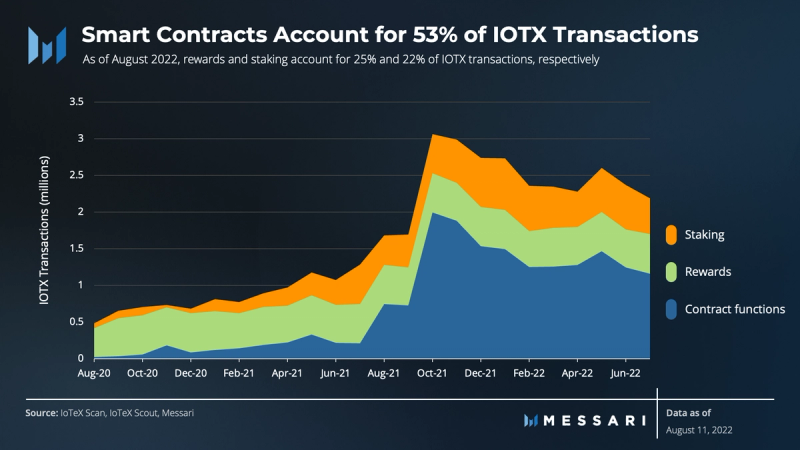
An analysis of transaction types sheds a light on the source of this stickiness. As of August 2022, smart contract functions account for 53% of IOTX transactions, indicating a healthy demand from dapps. Rewards and staking account for 25% and 22% of IOTX transactions, respectively.
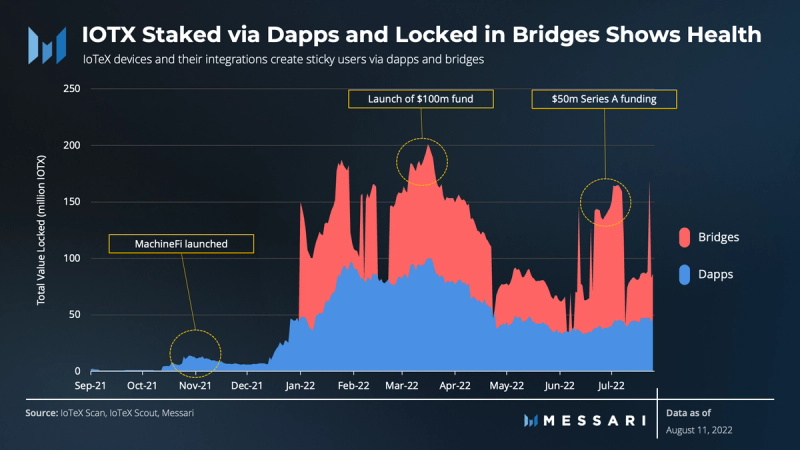
Another proxy for IOTX utilization is the value staked towards network activity via dapps and the value locked for bridged assets. As per August 2022, more than 86 million IOTX has been locked by dapps and bridges. This adds up to the nearly 3.04 billion IOTX staked by validators on the IoTeX network, representing a total of ~33% of the total token supply, up 11% year-over-year. While the total value staked towards network activity via dapps and the value locked for bridged assets is growing from a relatively low base, the growth dynamic may hint towards a steady development of the IoTeX ecosystem. Notably, there were several spikes throughout 2022, potentially driven by the following event catalysts:
- March 2022: a $100 million fund has been launched to support the growth of decentralized machine economy
- June 2022: MachineFi Lab announces a $50 million Series A funding, following a previous raise of $10 million to incentivize IoT data collection for Web3 in May 2022.
Tokenomics
June 2020 marked the launch of the IoTeX mainnet and its native token — IOTX. To transact on the network, users pay gas fees in IOTX, while developers expend IOTX as computing power to launch smart contracts or dapps. As of August 2022, device owners can also connect and send data to dapps by depositing IOTX tokens via the MachineFi Portal. Currently, staking IOTX serves governance purposes; in the future, service providers on the IoTeX network will also be required to stake IOTX.
Governance
To qualify as a delegate, one must fulfill the minimum node setup requirements, stake a minimum of 1.2 million IOTX and receive at least two million IOTX in total votes. IOTX holders exercise governance by voting for delegates.The top 36 delegates by votes qualify as consensus delegates, 24 of which get randomly selected to mine blocks for each epoch (every 8640 blocks – approximately 24 hours).
Any IOTX token holder can stake IOTX for voting power. Bonus votes are awarded for longer staking durations. Users may also vote for multiple delegates and increase their voting stake via the governance portal. In return for delegating votes, users receive a share of delegate rewards. As of August 2022, 75 consensus delegates are maintaining the IoTeX network with ~32% (3.04 billion IOTX) of the total token supply staked, up 11% year-over-year.
IoTeX provides a forum for its community to deliberate on key decisions. As per the recent update to governance from August 10, 2022, only delegates are allowed to submit proposal ideas on the forum. An idea becomes a formal proposal uploaded to the project’s Snapshot for voting once it receives over 50 community thread upvotes within the forum. Upon a successful vote, proposals are implemented.
Burning
The IOTX token features two burn mechanisms: “Burn-Drop” and “Burn-to-Certify.” The “Burn-Drop” mechanism is rolled-out in 10 phases.

It begins in phase 1, upon the first 1,000 IoTeX-based devices registered on the network. In the phase 1, 90,000 IOTX tokens were burned for every new device registered on the network. At the same time, 10,000 IOTX was airdropped to long-term stakers. Currently totaling 100,000 IOTX, this burn-drop rate gets halved in every subsequent phase, as the number of devices-per-phase doubles. As such, in phase 2, 45,000 IOTX are burned, and 5,000 IOTX are distributed to IOTX stakers for every additional device registered.
As of phase 3, in April 2021, the IoTeX team modified the Burn-Drop schedule to include a “drip” category. In phase 3, the burn amount for every additional phase was reduced to 25,000 IOTX. In addition, 25,000 IOTX was distributed via the drip. This process entailed supplying liquidity to IOTX trading pairs on IoTeX-based DEX, Mimo. LP tokens from these pools were then distributed with the remaining 25,000 IOTX to long-term stakers.
On August 10, 2022, the team explored replacing the schedule’s drip portion with a “MachineFi DAO” portion at the end of phase 5. The MachineFi DAO would receive a portion of IOTX from the burn drop program to fund MachineFi projects within the IoTeX ecosystem. If the IoTeX community votes in favor of this proposal, the IoTeX team will allocate IOTX to be burned, airdropped, and allocated to the MachineFi DAO in proportion of 50%, 25%, and 25%, respectively.
The Burn-Drop mechanism ends when the first million IoTeX-powered devices are registered. This milestone triggers the second burn mechanism, “Burn-to-Certify.” With Burn-to-Certify, IoT device manufacturers have to burn IOTX to access additional services for each new device. As of August 2022, the IOTX token is in the fourth phase of its Burn-Drop. With over 14,000 devices registered, roughly 2.8% of IOTX’s total supply (280 million IOTX) has been burned via this mechanism.
Protocol Fees
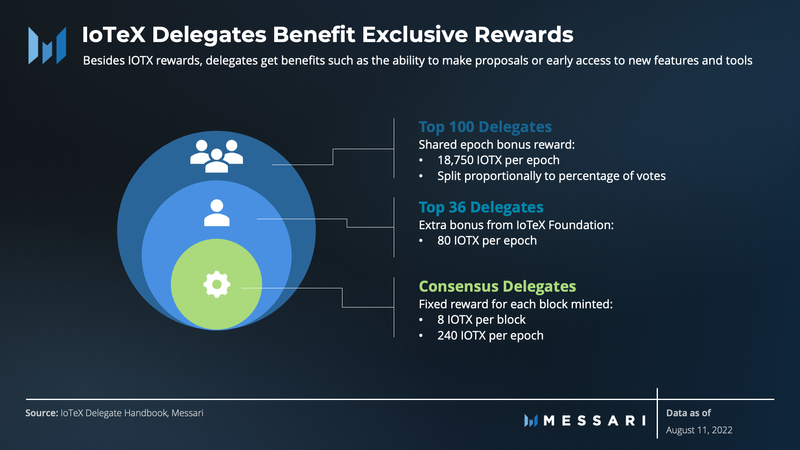
Consensus delegates are awarded 8 IOTX per block mined, supplied from the initial 12% (1.2 billion) reserve mining allocation. The top 36 delegates also receive 80 IOTX per epoch from the IoTeX Foundation, while the top 100 delegates proportionally split 18,750 IOTX per epoch, proportional to the percentage of votes. Furthermore, consensus delegates earn gas fees for processing transactions. In addition, MachineFi allows device owners to earn IoTeX standard tokens (XRC-20) for sharing their data with IoTeX-powered dapps.
Liquid Supply Curve
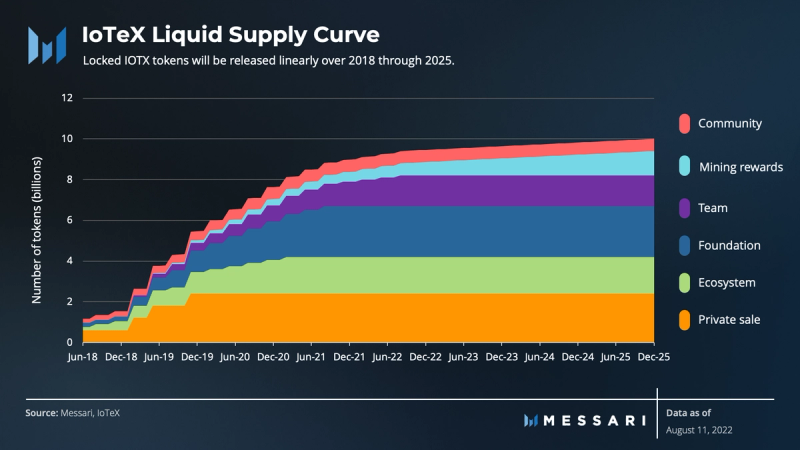
IOTX launched with a maximum supply of 10 billion, released linearly over 2018 through 2025. In 2018, the IoTeX project team privately sold 24% (2.4 billion IOTX) of the total supply to 50 accredited investors. IoTeX raised $20 million at the rate of 96,000 IOTX to 1 ETH in February 2018. It then distributed the private sale tokens from May 2018 to November 2019.
The team also allocated 18% of IOTX’s total supply to an ecosystem fund and 6% to a community rewards program in August 2019. It also allocated 25% (2.5 billion IOTX) to the IoTeX Foundation, 265 million IOTX of which was burned at the mainnet launch in June 2020. Notably, IoTeX allocated 15% of the total supply to its treasury, which will completely vest in August 2022. An additional 12% Roll-DPoS mining reward will be entirely issued by December 2025.
Ecosystem
As of August 11, 2022, there are over 168 dapps building on IoTeX. Use cases include MachineFi, DeFi, GameFi, and NFTs.
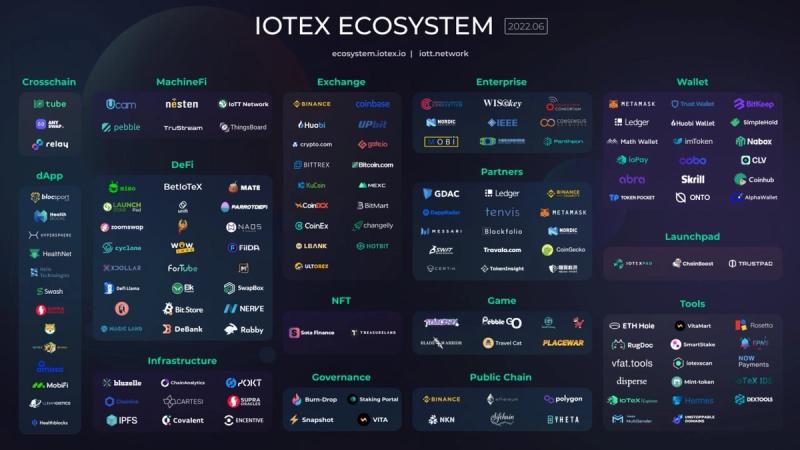
Source: IoTeX Foundation
Here are notable dapp examples over the past year:
- Mimo is a decentralized exchange on IoTeX that accounts for roughly 40% of IoTeX’s TVL and sees almost 500 daily active users as of August 2022.
- Filda is a decentralized money market on IoTeX that has more than $15 million worth of TVL as of August 2022.
- StarCrazy is an NFT gaming project with nearly 600 daily active users and a TVL of almost $900,000 as of August 2022.
- IoTube is a cross-chain bridge that connects the IoTeX network to notable EVM-compatible chains, including Ethereum, BNB Chain, and Polygon, with plans to support more networks. IoTube supports 39 assets and has bridged over $100 million worth of assets as of August 2022.
- ioPay is a multi-chain support crypto wallet that is available across multi-platforms, including desktop, mobile, and web. ioPay enables users to manage their assets across Ethereum, BNB Chain, Polygon, Avalanche, Fantom, Arbitrum and Cronos.
In addition, Pebble tracker has spurred the release of dapps on the IoTeX network that utilize real-world data. Notable apps built with Pebble tracker include the Proof-of-Presence (PoP) protocol and Meta-Pebble. PoP enables applications to tie verifiable real-world information to a user’s Web3 identity while preserving privacy. Meta-Pebble allows users to opt-in to dapps utilizing geolocation data in exchange for rewards. While PoP connects users’ real-world geolocation data to Web3 dapps, Meta-Pebble helps users monetize their data.
Another real-world dapp leveraging Pebble is HealthBlocks, a “live-to-earn” dapp that enables earning rewards by sharing fitness device data with healthcare providers. CityDAO, the first official DAO to own a 40-acre land in Wyoming, is also using Pebble to track sensor data on its land.
Enterprise Efforts
To support data ownership, privacy, and security, IoTeX partnered with enterprises, industry consortiums, and standardization bodies to develop blockchain-enabled IoT devices and services. IoTeX co-chairs the Industrial Internet Consortium (IIC) alongside Amazon and Huawei, on establishing frameworks for blockchain IoT enterprise use cases, decentralized identity and access management, and asset tracking.
IoTeX also serves as a (co-)chair for IEEE P2418.1 and IEEE P2958 Standards Working Groups, working with industry experts towards enterprise adoption of blockchain-empowered IoT architectures. As part of the Confidential Computing Consortium, IoTeX explores the new direction of securing and scaling off-chain computations with trusted execution environments (TEE) enabled machines, which opens new opportunities for cross-organizational data sharing and collaborations.
Development Roadmap
The IoTeX Foundation launched the Halo Grants Program in October 2021 to accelerate dapp development across DeFi, NFTs, infrastructure, developer tools, and gaming. It also launched an additional $100 million sustainable ecosystem fund in March 2022 to support Web3 and MachineFi-driven projects.
IoTeX launched MachineFi Lab in June 2022, aiming to develop the MachineFi economy. Following its launch, MachineFi Lab raised $10 million in a round led by Samsung Next, Draper Dragon Fund, and Jump Crypto. Since MachineFi Portal’s beta launch in January 2022, seven dapps have been deployed to its beta.
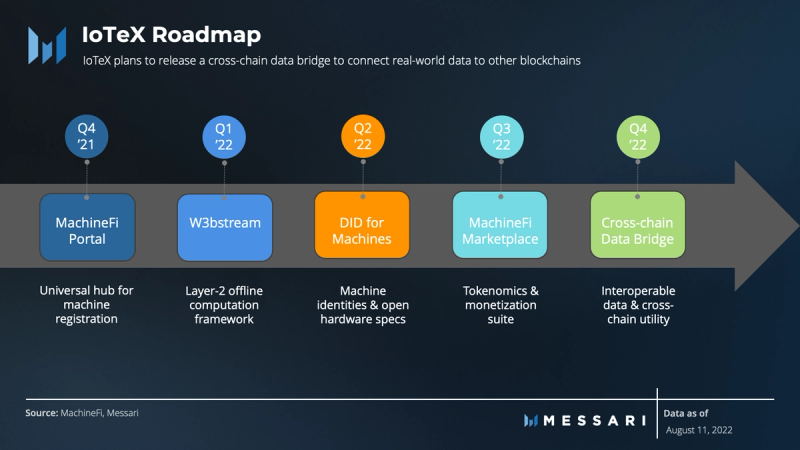
IoTeX plans to release a cross-chain data bridge to connect real-world data to other blockchains. The data bridge may strengthen IoTeX’s position as the universal hub for machine intelligence in Web3.
Competition
IoTeX efforts are unparalleled in Web3 — there are currently no other blockchain IoT projects as encompassing as IoTeX. While Helium is working towards a related goal, it specializes in hotspot (internet) infrastructure. VeChain is also a related project, as it incentivizes network participants to run a distributed network supporting dapps. VeChain enables businesses to digitally collaborate via enhanced data transfers and supply chain management solutions. Compared to Helium and VeChain, IoTeX operates at a broader scale – it connects a wider range of IoT-enabled machines in the real-world.
Another potential competitor could be IOTA, an IoT transaction settlement and data transfer layer. Although similar in service offerings, IOTA employs the Directed Acyclic Graph (DAG) to secure the safe control and exchange of data. While IOTA initially seemed to thrive in 2017, it fell behind due to the lack of real-world adoption.
Challenges and Opportunities
IoTeX must overcome several challenges to reach large-scale adoption. First, it’s difficult to onboard clients and partners onto its platform due to heterogeneous IoT hardware standards. Subsequently, the costs of maintaining IoT networks and enabling connectivity remain relatively high. Second, legacy IoT devices were not built for blockchain compatibility. IoTeX thus needs to provide additional support for legacy devices at reasonable costs. Third, there are privacy concerns for retail usage, e.g., biometrics tracking. Openly addressing these concerns and proactively educating less tech-savvy audiences may encourage more users to adopt the IoTeX platform.
In terms of opportunities, connected devices can mine, collect, and analyze data from daily activities. The enhanced level of interaction and connectivity could improve productivity while unlocking a broad range of future services. Additionally, IoT devices could feed data to DeFi smart contracts. That is, IoT devices could verify recorded data while being leveraged by smart contracts to boost new types of behavioral incentives.
Conclusion
Web3 is somewhat siloed due to its inability to connect to real-world activity. IoTeX aims to bridge this gap by establishing a single version of truth for real-world activity and connecting it to Web3. Using IoTeX, devices can capture and ingest what happens in the real-world to communicate these events to Web3 dapps.
IoTeX is poised for increased adoption as it plans to onboard new and legacy IoT devices without building them. This could spur the development of dapps with real-world use cases while rewarding users who generate these proofs via their IoT devices. The forthcoming release of a cross-chain data bridge may further strengthen the position of IoTeX as the universal hub for machine intelligence in Web3.

